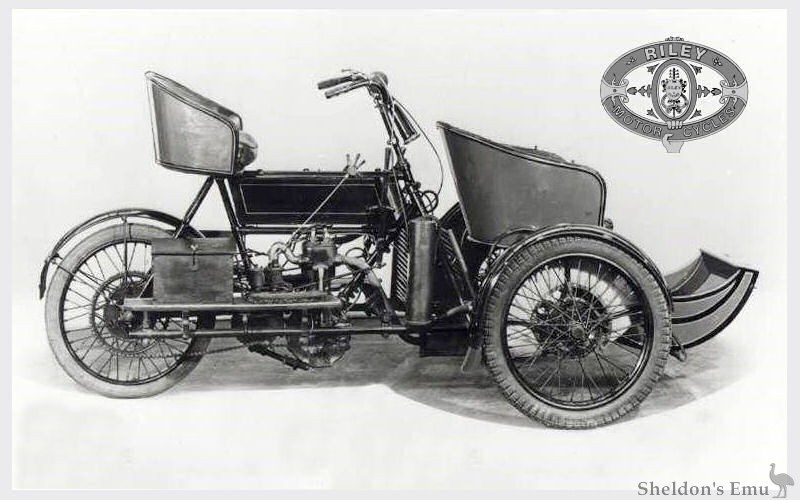


Triumph, BMW, & Kawasaki Sales Spares & Repairs.
Established for over 40 years and run by expert motorcyclists.
Fully authorised workshop.

Riley motorcycles were produced between 1899 and 1907, in Coventry.
1900 At about this time engines were changed to a 2¾ hp or a 3½ hp MMC.
1901 The first motorcycle appeared as a typically primitive solo fitted with a 1½ hp Minerva or a 2¾ hp MMC engine.
1902 A forecar design was added to the range.

1903 During the year a further option was added in the form of a 3½ hp MMC engine. The solos were advertised as the Moto-Bi. Late that year, Riley started fitting their own engines in the vertical mounting position, but still kept the Moto-Bi name. Engine sizes were 2.25-hp, 3-hp and 3.5-hp. The largest of those was intended for forecar use, with the option of water- or fan-cooling, and both forecars and sidecars were included in the range.
1904 The forecar was revised that year.
1905 A further forecar was added to the range.
1906 A fairly heavy machine appeared, fitted with a 6-hp, 804cc V-twin engine, but early in the year the production of motorcycles stopped and the company turned its attention firstly to tricars and then to motorcars.
1912 Spennell's lists them at St. Nicholas Street, Coventry (Wire, Kite; Tel. 216) and as manufacturers of motorcycles.
See also The Riley Company
Report from the 1902 Stanley Show
Another machine, fitted with 2.5 Minerva, is also shown, with tandem attachment, which can be taken on and off in a few minutes, and is well worth inspection. This can be fitted to any of these machines at slight extra cost.
Motor Cycling, 26th November 1902
Reports from the 1903 Stanley Show
One of the chief features in the new Riley Moto Bi is that the inclined engine of old is discarded and the more popular vertical position has been adopted. This is effected by a patented design of attachment. The system is a neat and effective one, and owing to the rigid manner in which the engine is fitted, vibration is reduced to a minimum.
Another special feature is that the engine fitted will be made expressly for the company by the Riley Engine Company, Coventry, embodying narrow crank case in conjunction with bearings of great width, valves of substantial proportions, mechanically-operated on a system recently patented by the Riley Engine Company. The fittings comprise a Longuemare carburetter, two P and R. accumulators with unspillable electrolyte, Bassee-Michel trembler coil. The Riley Moto Bi will he made in the following sizes:- 2.25 h.p. and 3.5 h.p., this latter is specially designed for fore-car, etc., use, and which may be had with either fan or water cooling. Prices range from 42 guineas.
The company are exhibiting two new designs of fore-cars, also side cars. etc., completing a most comprehensive programme for the coming season, and considering the recent development of the fore-carriage as a light motor vehicle the display should prove an interesting one, as the firm are making a special feature of these attachments. This exhibit will be found at the Stanley.
The Motor magazine, 18th November 1903
The motor bicycle is fitted with 3½ h.p. engine,
the bore and stroke of which are 86 mm. x 89 mm.
The engine is supported on the frame by a substantial fixing of their own design. The carburetter
- a Longuemare - is brought close up to the engine
in order to reduce the length of the induction valve, and the silencer, which is of large
dimensions, is well supported from the frame. Two sets of batteries are fitted and a two-way
switch, by which either
set of batteries may be used, or both sets together, on occasions when necessary. The application of
the front brake breaks the primary circuit. The exhaust valve-lifter lever is mounted on the same
handle-bar clip as the rim brake, and is provided with a triager to hold the valve open. A
forecarriage is shown, in which the tubes from the front axle converge on the engine, and the
steering post is supported at the bottom. as well as in the steering head. In the tank there is a
hollow division between the petrol and the lubricating oil compartments. This division is perforated
at the bottom, so that in the event of any leakage the oil or petrol will not be able to percolate
into the next compartment.
(Stand 126.)
The Motor Cycle, 25th November 1903
Mention was not made in our [Crystal Palace] show report last week of the Riley tricars and 9 h.p. car, as they were late in arrival. A trial car running in the grounds daily made light work of the stiff hills in the vicinity of the Palace.
The Motor Cycle November 1907.
Sources: Graces Guide, The Motor Cycle
If you have further information or a query related to this page, please contact us